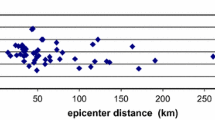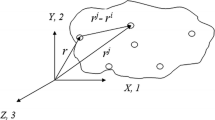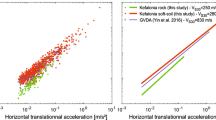Abstract
Two large explosions were recorded by a dense array of strong-motion accelerometers and rotational seismometers in northeastern Taiwan associated with a Taiwan Integrated Geodynamics Research long-range refraction experiment. The objective of this experiment was to test the response of the experimental eentec rotational seismometers against calculated array rotations. Computed array rotation rates are seen to have little variation across the array, but point rotation rate measurements obtained from individual rotational seismometers show significant deviations with each other and with the array rotation rates in the ranges of 3–5 Hz and, especially, 3–50 Hz. A cross-correlation method was used to compare array-computed rotation rates and point rotation rate measurements in the frequency band of 3–5 Hz with the result that the absolute value of the normalized maximum correlation coefficient for each station set varied from 0.45 to 0.97 with an average of 0.84. Amplitude differences of the point rotation rate measurements are seen to be factors of 0.2 to 1.8 times the array rotations as well. It is not likely that the differences seen in the point and array-computed rotation rates are due to nonlinear or heterogeneous site conditions under each array element since these effects should also be seen in the acceleration data used to determine rotation rate. A rigorous method for accurately calibrating rotation rate instruments is needed to understand their response in the field.






Similar content being viewed by others
References
Goldstein P, Dodge D, Firpo M, Minner L (2003) SAC2000: signal processing and analysis tools for seismologists and engineers. In: Lee WHK, Kanamori H, Jennings PC, Kisslinger C (eds) The IASPEI international handbook of earthquake and engineering seismology. Academic, London
Gomberg J, Pavlis G, Bodin P (1999) The strain in the array is mainly in the plane (waves below 1 Hz). Bull Seismol Soc Am 89(6):1428–1438
Grazier VM (2005) Effect of tilt on strong motion data processing. Soil Dyn and Earthq Eng 25:197–204
Langston CA (2007) Spatial gradient analysis for linear seismic arrays. Bull Seismol Soc Am 97(1B):265–280
Langston CA, Liang C (2008) Gradiometry for polarized seismic-waves. J Geophys Res 113:B08305
Langston CA, Nyblade AA, Owens TJ (2002) Regional wave propagation in Tanzania, East Africa. J Geophys Res 107:B1. doi:10.1029/2001JB000167
Langston CA, Lee WHK, Lin CJ, Liu CC (2009) Seismic-wave strain, rotation, and gradiometry for the 4 March 2008 TAIGER explosions. Bull Seismol Soc Am 99(2B):1287–1301
Lee WHK, Huang BS, Langston CA, Lin CJ, Liu CC, Shin TC, Teng TL, Wu CF (2009a) Review: progress in rotational ground-motion observations from explosions and local earthquakes in Taiwan. Bull Seismol Soc Am 99(2B):958–967
Lee WHK, Igel H, Trifunac MD (2009b) Recent advances in rotational seismology. Seismol Res Lett 80(3):479–490
Liang C, Langston CA (2009) Wave gradiometry for USArray: Rayleigh waves. J Geophys Res 114. doi:10.1029/2008JB005918
Lin CJ, Liu CC, Lee WHK (2009) Recording rotational and translational ground motions of two TAIGER explosions in northeastern Taiwan on 4 March 2008. Bull Seismol Soc Am 99(2B):1237–1250
Nigbor RL (1994) Six-degree-of-freedom ground-motion measurement. Bull Seismol Soc Am 84(5):1665–1669
Nigbor RL, Evans JR, Hutt CR (2009) Laboratory and field testing of commercial rotational seismometers. Bull Seism Soc Am 99:1215–1227
Pavlis GL, Vernon FL (1994) Calibration of seismometers using ground noise. Bull Seism Soc Am 84:1243–1255
Schreiber KU, Hautmann JN, Velikoseltsev A, Wassermann J, Igel H, Otero J, Vernon F, Wells JPR (2009) Ring laser measurements of ground rotations for seismology. Bull Seism Soc Am 99:1190–1198
Spudich P, Steck LK, Hellweg M, Fletcher JB, Baker LM (1995) Transient stresses at Parkfield, California, produced by the M 7.4 Landers earthquake of June 28, 1992: observations from the UPSAR dense seismograph array. J Geophys Res 100:675–690
Stupazzini M, Puente J, Smerzini C, Kaser M, Igel H, Castellani A (2009) Study of rotational ground motion in the near-field region. Bull Seismol Soc Am 99(2B):1271–1286
Takeo M (1998) Ground rotational motions recorded in near-source region of earthquakes. Geophys Res Lett 25(6):789–792
Wassermann J, Lehndorfer S, Igel H, Schreiber U (2009) Short note: performance test of a commercial rotational motions sensor. Bull Seismol Soc Am 99(2B):1449–1456
Acknowledgments
We would like to thank the Center for Earthquake Research and Information at the University of Memphis for funding support. The manuscript was improved by comments made by two anonymous reviewers.
Data and resources
All translational and rotational seismograms described in this paper were collected by Chin-Jen Lin, Chun-Chi Liu, and William H. K. Lee and are archived on the website of the International Working Group on Rotational Seismology (http://www.rotational-seismology.org, last accessed July 2011). Seismic Analysis Code (Goldstein et al. 2003) and MATLAB (matrix laboratory) were used in the data processing and are gratefully acknowledged.
Author information
Authors and Affiliations
Corresponding author
Rights and permissions
About this article
Cite this article
Kendall, L.M., Langston, C.A., Lee, W.H.K. et al. Comparison of point and array-computed rotations for the TAIGER explosions of 4 March 2008. J Seismol 16, 733–743 (2012). https://doi.org/10.1007/s10950-012-9297-4
Received:
Accepted:
Published:
Issue Date:
DOI: https://doi.org/10.1007/s10950-012-9297-4




